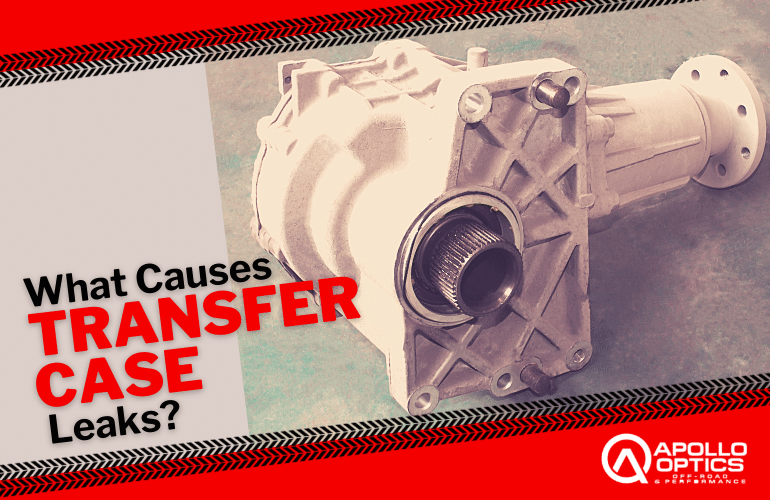 Few individual components are as valuable to the operation of a four-wheel-drive vehicle as the transfer case. A transfer case serves as the integral point of connection between a Jeep, truck, or SUV’s front and rear differentials, thereby allowing drive motion to take place at each of a vehicle’s four-wheel ends.
Few individual components are as valuable to the operation of a four-wheel-drive vehicle as the transfer case. A transfer case serves as the integral point of connection between a Jeep, truck, or SUV’s front and rear differentials, thereby allowing drive motion to take place at each of a vehicle’s four-wheel ends.
However, like any component requiring internal lubrication, a transfer case is prone to leakage. In fact, most transfer cases will experience a leak of one type or another within their service life, especially when regularly engaged to facilitate 4WD operation.
Prior to repairing a transfer case leak, one must first determine its point of origin. At times, this can prove somewhat difficult to do. To aid in this process, it is important to understand all possible causes of a transfer case leak, thereby allowing you to focus your efforts where necessary.
The following guide will assist you in understanding the inner workings of your vehicle’s transfer case, as well as potential causes of any leak that you might experience.
How Does a Transfer Case Work?
A transfer case, when engaged, provides torque via a secondary driveshaft in order to place drive power at each front-end wheel location. In essence, a transfer case locks a 4WD-capable vehicle’s front and rear driveshafts together, thereby allowing torque to be divided between the front and rear wheels.
Many stock transfer cases rely upon the use of a chain to facilitate lockup, as this design has proven to be relatively quiet in operation. However, a significant number of dedicated transfer cases used in serious off-road applications are of a gear-driven nature. These transfer cases, though noisier than their chain-driven companions, are known for their extreme durability.
Transfer cases also vary from one unit to the next in terms of application longevity. While some transfer cases are of a part-time design and engage only when selected to do so, others remain engaged in an ongoing or full-time basis. The latter of these two transfer case types are most prominent in many late-model makes. Full-time 4WD systems are similar to those used in all-wheel drive vehicles, albeit with the addition of a low-range option.
The Importance of Repairing a Transfer Case Leak
A transfer case is a sealed system which contains its own lubricating oil. The type of oil contained within a vehicle’s transfer case varies by model and manufacturer specifications. While some transfer cases are specified for use with standard gear oil, many others call for the use of transmission fluid or other various specialty lubricants.
However, a transfer case leak will inevitably reduce such a unit’s fluid level. This, in turn, leads to additional wear of a transfer case’s internal components. As a result, any number of failures can occur, leaving you with a much larger issue than just a minor fluid leak. In the most severe of cases, oil-starved transfer case bearings can seize, thereby locking up the transfer case itself.
If a transfer case fluid leak is discovered, it is imperative to fill the system back to its standard operating level until proper repairs can be made. When in doubt, contact your local dealership or consult your owner’s manual when determining which type of oil to use. In most cases, a differential will feature a dedicated fill plug whereby this lubricant can be added.
Causes of Transfer Case Leaks
Transfer case leaks occur for a number of reasons, almost all of which require a different plan of action for repair. While the root cause of a transfer case leak often proves to be relatively minor in severity, other leaks can be far more complex to remedy.
The following are some of the most common causes of a leaking transfer case.
Leaking Transfer Case Output Shaft Seal
A transfer case features output shaft seals that protect against the loss of fluid around each corresponding output shaft. Over time, these seals begin to dry out and become brittle. When this occurs, an output shaft seal will start to leak fluid. This leak often increases in severity over time as the seal further deteriorates. A leak of this type can often be identified by the slinging of oil from a given output shaft. Alternatively, the oil seal itself will typically look wet to the eye.
Worn Bearings
In certain cases, progressive wear of a transfer case’s internal components can cause an oil leak to occur. This is especially true of high-mile transfer cases that have seen more than their share of use. Such issues typically arise when an input or output shaft bearing experiences play. This excessive free-play rapidly destroys the seal behind it, causing leaks of varying severity. If you have attempted to stop a prior leak by installing a new seal, only to incur a second leak at the same spot, internal bearing wear is almost always to blame.
U-Joint Irregularities
A vehicle’s drivetrain components are reliant upon the proper operation of all driveline u-joints to prevent binding. If these u-joints begin to seize or otherwise wear to the point of creating a driveline vibration, differential and t-case leaks often result. This repetitive vibration eats away at an output or input shaft seal’s ability to retain fluid, thereby resulting in fluid leaks. To remedy this concern, the offending u-joint must be replaced in order to prevent a newly installed seal from falling victim to the same fate.
Bad Housing Gasket
The vast majority of transfer cases can be parted at a centralized seam, located along the widest point of the case’s housing. This allows access to a transfer case’s chain, drive gears, and additional internal components. Sealing the two halves of this housing is a specialty housing gasket. With time, gaskets of this nature tend to deteriorate and can become compromised to the point of allowing fluid to bypass. When this occurs, it will be necessary to part the transfer case and replace the gasket within.
Loose Plugs
The vast majority of transfer cases feature both fill and drain plugs. A transfer case’s fill plug is typically found above the housing's central line, while the drain plug is almost always located at the very bottom of the transfer case housing. If either of these plugs were to be left loose for any reason, a certain amount of fluid would almost certainly escape. While this seems rather elementary in concept, loose transfer case plugs are responsible for far more leaks than one would be inclined to think.
Determining the Source
In certain cases, a transfer case leak can be severe enough to leave the majority of the unit’s housing covered in oil. When this occurs, locating the root cause of such a leak can seem to be an uphill battle. However, a few quick steps can be taken to narrow down your search. These steps are as follows.
Look High: When attempting to locate the root cause of an oil saturated transfer case, it can be helpful to begin your search at the upper expanse of the unit’s housing. Gravity naturally carries leaking fluids downward. Therefore, one can easily rule out most any possible leak source that lies above the line of saturation.
Spray It Off: If the source of your transfer case’s leak still remains unclear, it can be helpful to completely clean the exterior of the unit’s housing. This can be easily done with the use of store-bought degreaser and a pressure washer. Simply top off your transfer cases fluid level, reinstall all plugs, clean the housing in its entirety, and watch for recurring fluid drips/runs.
Take a Cruise: If no drips or leaks have recurred after washing your transfer case’s housing, it might be necessary to take your Jeep, truck, or SUV for a quick jog up the road. In most cases, a drive of only ten miles will be enough to force a leak to show itself. Upon returning from your drive, park your vehicle in a safe location, and crawl underneath for a quick inspection.

